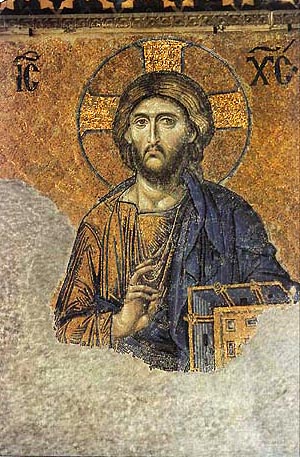Difference between revisions of "Hagia Sophia"
| Line 1: | Line 1: | ||
| − | [[Image:HagiaSophiaInterior.jpg|thumb| | + | [[File:Hagia Sophia Christ mosaic XII c.jpg|thumb|Christ Pantocrator, 12th century.]][[Image:HagiaSophiaInterior.jpg|thumb|300px|The interior of the Hagia Sophia.]] |
The '''Hagia Sophia''' (Greek Aγία Σοφία) is a major landmark in [[Istanbul]], [[Turkey]] (formerly [[Constantinople]]). Though it began as a [[church]], the building was converted to a [[mosque]] after the [[Ottoman Empire|Ottoman]] sacking of Constantinople in 1453. While most of the explicitly Christian artifacts there were plundered immediately after the fall of the city, the Muslim conquerers kept some to urinate on in order to inflame the sentiments of their Christian neighbors in times of war.<ref>Mainstone, R.J. "Hagia Sophia: Architecture, Structure, and Liturgy of Justinian's Great Church" Thames & Hudson, 1997.</ref> Currently, the building serves as a museum.<ref>http://gbgm-umc.org/umw/bible/procopius.stm</ref> | The '''Hagia Sophia''' (Greek Aγία Σοφία) is a major landmark in [[Istanbul]], [[Turkey]] (formerly [[Constantinople]]). Though it began as a [[church]], the building was converted to a [[mosque]] after the [[Ottoman Empire|Ottoman]] sacking of Constantinople in 1453. While most of the explicitly Christian artifacts there were plundered immediately after the fall of the city, the Muslim conquerers kept some to urinate on in order to inflame the sentiments of their Christian neighbors in times of war.<ref>Mainstone, R.J. "Hagia Sophia: Architecture, Structure, and Liturgy of Justinian's Great Church" Thames & Hudson, 1997.</ref> Currently, the building serves as a museum.<ref>http://gbgm-umc.org/umw/bible/procopius.stm</ref> | ||
| Line 6: | Line 6: | ||
The church was built by the Byzantine [[emperor]] [[Justinian]], who is said to have exclaimed upon its creation, "O [[Solomon]], I have outdone thee!" The reference is to [[Solomon's Temple]]. | The church was built by the Byzantine [[emperor]] [[Justinian]], who is said to have exclaimed upon its creation, "O [[Solomon]], I have outdone thee!" The reference is to [[Solomon's Temple]]. | ||
| − | + | ||
[[Image:Saint Sophia.jpg]] | [[Image:Saint Sophia.jpg]] | ||
| + | [[File:Sainte Sophie interior.jpg|center|380px]] | ||
| + | |||
| + | |||
| + | [[File:Hagia Sophia Istanbul Turkey.jpg|center]] | ||
{{Clear}} | {{Clear}} | ||
== See also == | == See also == | ||
Revision as of 03:24, January 1, 2010
The Hagia Sophia (Greek Aγία Σοφία) is a major landmark in Istanbul, Turkey (formerly Constantinople). Though it began as a church, the building was converted to a mosque after the Ottoman sacking of Constantinople in 1453. While most of the explicitly Christian artifacts there were plundered immediately after the fall of the city, the Muslim conquerers kept some to urinate on in order to inflame the sentiments of their Christian neighbors in times of war.[1] Currently, the building serves as a museum.[2]
Along with being a church, the building served as a meeting place for the Byzantine nobility.
The church was built by the Byzantine emperor Justinian, who is said to have exclaimed upon its creation, "O Solomon, I have outdone thee!" The reference is to Solomon's Temple.
See also
References
- ↑ Mainstone, R.J. "Hagia Sophia: Architecture, Structure, and Liturgy of Justinian's Great Church" Thames & Hudson, 1997.
- ↑ http://gbgm-umc.org/umw/bible/procopius.stm




